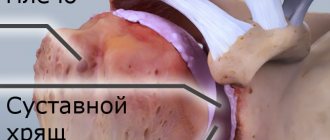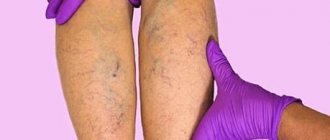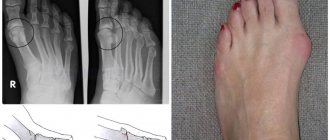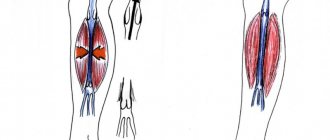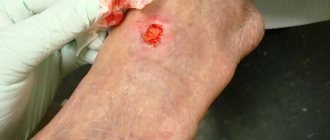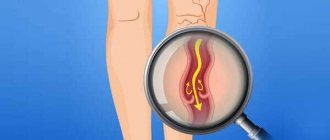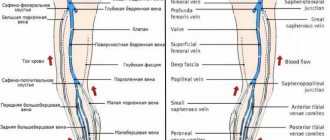Ankle arthritis is an inflammatory disease of the musculoskeletal system. As a result of the development of pathology, the patient experiences inflammation of the joint of the leg with the foot, and the mobility of the foot is limited.
Destructive damage to the ankle joint can develop at different ages. The greatest risk of its occurrence exists among men. The inflammatory process significantly reduces the quality of life of patients and requires timely and adequate treatment.
Why does it hurt
The ankle is the articulation of three bones - the fibula, tibia and talus. They are all connected to tendons. Around it there are many muscles responsible for flexing the sole. If mechanical or degenerative damage occurs in this structure, pain occurs.
Most often, the ankle joint hurts for the following reasons:
- ankle arthrosis;
- arthritis due to partial or complete dislocation;
- gout;
- tendinitis;
- tunnel syndrome;
- heel bone fracture;
- pathology of the anatomical structure of the joint.
People who lead a sedentary lifestyle are most susceptible to ankle diseases. Ligaments and muscles become flaccid, lose the ability to exercise, and therefore react to them with dislocations, sprains and fractures. Also at risk are people with increased body weight, flat feet, the elderly and athletes.
Arthrosis is not the only possible cause of pain in the ankle joint
Prognosis and prevention
A qualified physician can slow the progression of ankle arthritis and relieve pain. The doctor will give effective recommendations for preventing damage. Patients at high risk of inflammatory processes are advised to:
- Maintain normal body weight.
- Quit alcoholic beverages and smoking.
- Stick to a healthy diet.
- Maintain normal physical activity.
- Treat infectious lesions in a timely manner.
- Regularly undergo preventive examinations.
How to understand what the reason is
A doctor should carry out the diagnosis, so if you have pain or discomfort in your foot, you should not put off visiting a specialist. But already at the initial stage you can independently navigate the symptoms:
- With arthritis, the joint becomes inflamed suddenly, without provoking factors such as injury. The pain occurs mainly at night and disappears when walking.
- When the ankle bones are fractured, the bone structures of the ankle are also damaged. Swelling is visible, you experience pain at the slightest step on the foot.
- With tunnel syndrome, compression of the walls of blood vessels and nerve roots occurs (for example, this happens with diabetes, after an injury, or against the background of arthrosis). Extensive edema forms, a cooling of the limb is observed, which is replaced by a local increase in temperature.
- With tendinitis, the tendons become inflamed and swelling occurs. Pain occurs when putting weight on the leg. If left untreated, there is a risk of infection and rupture of tendon fibers.
- With gout, severe pain occurs mainly during sleep. The pain is acute, spreads to the entire foot and radiates to the big toe. Gout and salt deposition have nothing in common with arthrosis in nature, with the exception of pain.
- When the heel bone is fractured, extensive swelling, hematomas are noticeable, the foot hurts, and motor activity decreases. This problem is relevant for runners and can lead to chronic pain.
- With partial or complete dislocation, the bone tissue of the ankle thickens and the heel turns inward. The joint becomes deformed, causing extensive swelling and prolonged pain.
Unlike problems of a traumatic nature, arthrosis does not have such pronounced symptoms. With degenerative changes in the cartilage, the ankle hurts and is somewhat limited in mobility. Symptoms are often vague, so a person does not rush to consult an orthopedist, but experiments with gels, ointments, local remedies, traditional medicine and wastes precious time.
With arthrosis, there are no visible signs - swelling, hematomas
Exercise therapy
Treatment of foot joint disease is impossible without performing a set of physical exercises. This point is a prerequisite in any therapeutic regimen for arthritis. For the treatment of foot joints, the complex is selected individually.
However, there are several universal exercises that can be performed by everyone without exception:
- It is performed lying on your back with your arms and legs extended. Then you need to raise your legs and try to stretch your toes as far as possible. After that, lower your legs back, and only then stop stretching them.
- Sit on a hill, such as a table. Lower your legs down and stretch your toes, trying to reach the floor with them.
- Bend and straighten your toes.
- Lie on the floor, but on your side. Move the extended leg to the side and return it back.
You need to start training during the period of remission of the disease, so as not to provoke increased inflammation. For the first time, it is best to train under medical supervision, so that the doctor makes sure that the patient is performing all the exercises correctly.
In what cases is specialist help for pain urgently needed?
You should not delay contacting a doctor under the following symptoms and circumstances:
- the ankle joint hurts and is very swollen, because of this you are unable to put on shoes;
- due to intense pain you cannot lean on your leg;
- noticed instability of the ankle, loosening (occurs with complete or partial rupture of the ligaments);
- pain occurs when you stand;
- the soreness is felt not only in the muscles, but also deep in the ankle.
Severe pain in the ankle is not a reason to try traditional medicine
Diagnostics
Have you noticed the presence of several symptoms, but don’t know which doctor treats arthritis? Feel free to seek help from specialists such as a rheumatologist, traumatologist, or therapist (including a chiropractor).
In order to diagnose arthritis of various types, an integrated approach is used, which involves primary and secondary examination of the patient. Modern medicine distinguishes two main methods:
- laboratory (blood and/or immune system testing);
- instrumental (x-ray/ultrasound examination, computed tomography/magnetic resonance imaging, arthroscopy, myelography).
How to deal with ankle pain
You shouldn’t fight this joint pain on your own: it’s better to get diagnosed and follow the recommendations of an orthopedist or rheumatologist. The specialist will conduct a physiological examination and collect anamnesis, and prescribe stress tests of the foot. During the examination, the condition and functioning of the nerve roots will also be assessed. If necessary, the patient will be sent for an X-ray or MRI.
The treatment regimen for osteoarthritis is fundamentally different from the treatment for gout or recovery from injury.
In case of injury, the doctor’s actions depend on the type of injury:
- in case of a fracture, a plaster cast is applied to the damaged area, but before this, surgical displacement of the bones is sometimes performed;
- the dislocation is first reduced, then an orthosis with rigid lateral parts or a plaster cast is applied to prevent swelling and properly fix the leg;
- When sprained, soft orthoses or fixing bandages are relevant.
For ankle injuries, it is important to reduce the load on the limb
Arthritis
About 350 million people worldwide have arthritis. For example, in the United States it is noted that almost 22 percent of the population (40 million, including 250 thousand children) have some form of arthritis and often other terms are used to refer to the inflammatory process in the joints, such as arthralgia, arthropathy or arthrosis .
Data
- Arthritis is inflammation of one or more joints.
- Symptoms of arthritis include pain and limited joint function.
- Arthritis can affect both men and women, adults and children.
- Arthritis is treated by a rheumatologist.
- Early diagnosis can help prevent permanent damage and disability.
The disease is often accompanied by joint pain (arthralgia). There are many different reasons for the development of inflammation in the joints. These may be trauma (osteoarthritis), metabolic disorders (for example, gout or pseudogout), hereditary factors, direct and indirect effects of infections (bacterial or viral), disorders of the immune system with an autoimmune component (for example, rheumatoid arthritis and systemic lupus erythematosus) . Common to all types of arthritis are that both joints and tendons, muscles, ligaments, cartilage are affected, and internal organs are often affected. With some types of arthritis, especially of autoimmune origin, internal organs (heart, lungs, kidneys) are affected and the patient may have general symptoms, such as fever, chronic fatigue, weight loss, and swollen lymph nodes.
Symptoms
Symptoms of arthritis include pain and limited mobility in the joints. Joint inflammation is characterized by stiffness, swelling, redness and a local increase in temperature in the joint area. There may also be pain in the joint area. With many types of arthritis, symptoms occur in other organs that are not directly related to the joints. Thus, patients with arthritis may have symptoms such as fever, swollen lymph nodes, weight loss, and symptoms of dysfunction of organs such as the lungs, heart, or kidneys.
Diagnostics
The first step in diagnosing arthritis is to consult a rheumatologist. The doctor analyzes the history of the disease, symptoms, examines the joints, determines the presence of inflammation in the joint area, the presence of deformity, and also checks for the presence of somatic problems that may cause the development of joint inflammation. Various methods are used to diagnose arthritis, such as laboratory tests, radiography, and ultrasound. In some cases, diagnosing the type of arthritis requires multiple visits to a rheumatologist, who is a specialist who deals directly with arthritis. Timely diagnosis allows you to prescribe adequate treatment and avoid serious complications, both from the joints and often from internal organs.
It should be noted that both before and especially after a diagnosis of arthritis, maintaining contact with a doctor is of great importance, as it allows you to monitor both changes in the course of the disease and the possibility of adjusting treatment and safe use of medication (some drugs have a number of side effects ).
Treatment
Treatment for arthritis depends on the specific type of arthritis. As a rule, an integrated approach is used, including both medicinal treatment methods (NSAID painkillers to influence the immune system) and non-drug treatment methods (physiotherapy, exercise therapy).
For most forms of arthritis, diet plays little or no role in treatment, but omega-3 fatty acids found in fish have been shown to have a beneficial role. At the same time, with some types of arthritis (for example, gout), eating a number of foods high in purines (red meat, shellfish) or foods such as beer can trigger an exacerbation of the disease. With the same disease as celiac disease, taking foods containing gluten (wheat, barley, rye) can lead to increased joint pain.
The prognosis for patients with arthritis depends on the severity of the inflammatory processes, the presence of complications, and the presence of concomitant lesions of internal organs. For example, rheumatoid arthritis often leads to damage to the lungs, kidneys, eyes, etc. Chronic joint inflammation can lead to permanent joint damage and loss of joint function, making joint movement difficult or impossible.
Since most forms of arthritis are genetically determined, there are no real methods of prevention. But it is possible to prevent arthritis associated with injury or arthritis caused by infection (for example, septic arthritis, reactive arthritis, Whipple's disease).
How to quickly help yourself in case of an ankle injury
If you feel severe pain in your foot due to injury or severe mechanical stress, do the following:
- place your foot on a small hill;
- remain in this position until the pain becomes less intense;
- apply a cold compress of ice wrapped in thick cloth for 20 minutes;
- eliminate the load on the leg, swaddle the injured foot tightly with a bandage (relevant during the first two days);
- As soon as possible, go to the doctor.
A cold compress of ice helps in the first hours after injury
Folk remedies
A lot of traditional medicine recipes for the treatment of foot arthritis have been accumulated, but any of them can only be considered as a useful addition to the main therapy prescribed by the doctor.
- Mix approximately 100 ml of the juice of one lemon with 50 ml of hot water, moisten multi-layer gauze and apply to the joint overnight, fixing the compress with cling film and putting a woolen sock over it;
- Mix ground equal parts of radish, turnip and horseradish leaves and rub the resulting mixture on the affected area. Repeat the procedure for 7 days.
- Apply a mixture of warm sea salt with a few drops of fir essential oil to a joint heated in a warm bath, wrap the foot in gauze, film and also insulate it with a sock.
- Measure out 100 g of finely chopped cinquefoil, pour in 1 liter of vodka and leave to steep for two weeks. Take the resulting mixture one tablespoon at a time, be sure to dilute it with a small amount of water. In addition, you can apply liquid in the form of a compress to joints damaged by arthritis. After the tincture runs out, take a break of 30 days before the next course.
- Cabbage compress. Cut a washed cabbage leaf to release the juice, wrap the painful, inflamed area, and bandage it. Change the cabbage after an hour (or earlier), when the juice is absorbed and the leaf becomes dry and warm. Harmless, proven product.
The prognosis depends on the degree of neglect of the disease, as well as the correctness of the chosen course of therapy. If it was possible to start treatment in a timely manner, the prognosis is generally favorable. If the joints are severely inflamed and a serious deformity of the feet has developed, then the treatment will be very painful and may not lead to the desired effect - there is a risk of lameness, gait disturbance and even disability.
What is prescribed for chronic pain
Therapy for arthrosis and arthritis, gout and tendonitis will be different. Almost always, at the initial stage of treatment, the patient is prescribed painkillers in the form of tablets or injections. If there is an infection and an open wound, antibiotics are required. In different cases, it is advisable to take a course of anti-inflammatory drugs and antihistamines. The patient will also be recommended a set of exercises to strengthen the feet and ankles.
Also, for chronic pain, depending on the diagnosis, the following may be prescribed:
- local remedies;
- vitamin complexes with calcium and vitamin D;
- chondroprotectors;
- drugs from the antirheumatic group;
- drugs to improve blood circulation.
Special gymnastics helps to strengthen the ankle and prevent possible injuries, for example:
For arthrosis, intra-articular injections of a synovial fluid prosthesis directly into the joint cavity are indicated. It is impossible to completely cure this chronic disease, but it is quite possible to reduce the severity of pain caused by friction of damaged cartilage. The gel enters the joint and pushes the rubbing surfaces apart, and also improves the shock-absorbing properties of the synovial fluid. This therapeutic method is considered the most progressive today.
Additional therapy measures
In the acute phase of the disease, a plaster splint may be applied. Auxiliary methods of treating the disease are:
- physiotherapeutic procedures;
- special gymnastics;
- massage;
- mud therapy;
- amplipulse therapy;
- magnetic therapy;
- Hirudotherapy is used in case of metabolic disorders.
- Wearing special shoes also gives positive results.
In advanced stages of arthritis, surgical intervention may be required: arthroplasty or joint replacement. If there is significant deformation of the thumb, resection is advisable.
During the acute period of the disease, it is necessary to reduce the load on the damaged joint as much as possible and apply a fixing bandage to avoid an increase in the inflamed area.
Arthrosis of the metatarsophalangeal joints: what is it?
The metatarsophalangeal joints are ball and socket joints. They are formed by the articular surfaces of the heads of the metatarsal bones and the bases of the proximal phalanges. The ends of the bones that form the joint are covered with thin cartilage tissue. The articular capsules are attached along the edge of the articular cartilages and are thinned on the outside of the foot. On the opposite edge and sides they are strengthened by plantar and collateral ligaments, respectively. In this case, between the heads of the metatarsal bones there is a deep transverse metatarsal ligament.
The structural features of the metatarsophalangeal joints make them susceptible to the development of degenerative-dystrophic changes (arthrosis) and inflammatory processes (arthritis). Moreover, arthrosis is often complicated over time by the development of arthritis. This significantly worsens the well-being of patients.
Arthrosis is called damage to the cartilage tissue covering the heads of the metatarsal bones and the bases of the proximal phalanges of varying degrees of severity. Initially, the cartilage becomes dehydrated and thins, becoming covered with microscopic cracks. But gradually, under the influence of loads or other factors, they increase in size and take on the appearance of large cracks and depressions. This leads to a decrease in the size of the joint space, which causes difficulties in movement and prevents the free sliding of the heads of the bones.
As a result, there is an increase in load and increased friction between bone surfaces. This is accompanied by the formation of osteophytes on them, i.e. bone growths. They may have sharp edges that will injure surrounding tissues and the joint capsule. As a result, over time, arthrosis of the metatarsophalangeal joints can be complicated by arthritis, that is, the addition of an inflammatory process.
Most often, arthrosis affects the metatarsophalangeal joint of the 1st toe or big toe. In this case, hallux rigidus is diagnosed. It is somewhat less common to diagnose arthrosis of the joint of the 2nd finger and extremely rarely of the others. This is due to the fact that the first finger bears the main load when walking, standing and physical activity.
The main danger of the disease is the occurrence of severe deformities of the joints, which will lead to a significant decrease or even complete loss of their functionality. As a result, patients may experience difficulty moving, even to the point of losing the supporting ability of the foot. The risk of local circulatory disorders also increases sharply. This increases the likelihood of developing varicose veins of the lower extremities.
Symptoms of arthrosis of the metatarsophalangeal joints
The disease is characterized by smooth progression. Therefore, it can develop completely unnoticed over several years, and at this time a person does not even suspect the presence of deviations from the norm in the condition of these small joints of the foot. Only in isolated cases, usually after injuries, does the disease begin acutely.
But gradually the intensity of the symptoms of arthrosis of the metatarsophalangeal joints increases. The disease is characterized by:
- the occurrence of pain that increases over time in the area of the bases of the phalanges of the fingers;
- the formation of subcutaneous dense protrusions that can be felt independently (this may be accompanied by painful sensations);
- swelling;
- gait disturbances in the form of instability, lameness, clubfoot;
- a sharp increase in pain in the foot when standing and walking;
- increased leg fatigue;
- limited mobility of affected joints;
- formation of calluses in the joint area.
Most often, arthrosis of the 1st metatarsophalangeal joint or big toe is observed. This is accompanied by the formation of a bone growth or exostosis in the projection of the affected joint (on the lateral surface of the foot). This kind of thing is usually called a bump or a bone.
In this case, the thumb gradually deviates towards the neighboring ones, and the callus increases in size. This is accompanied by severe pain, and swelling and redness of the soft tissues may also occur. The formation causes discomfort when wearing tight shoes, and over time, patients may notice that previously comfortable shoes or boots have become too tight. In the future, exostosis causes difficulties in choosing shoes, and a big toe that deviates from the normal axis provokes deformation of neighboring ones. Thus, arthrosis of the 1st metatarsophalangeal joint can lead to the development of hallux valgus.

